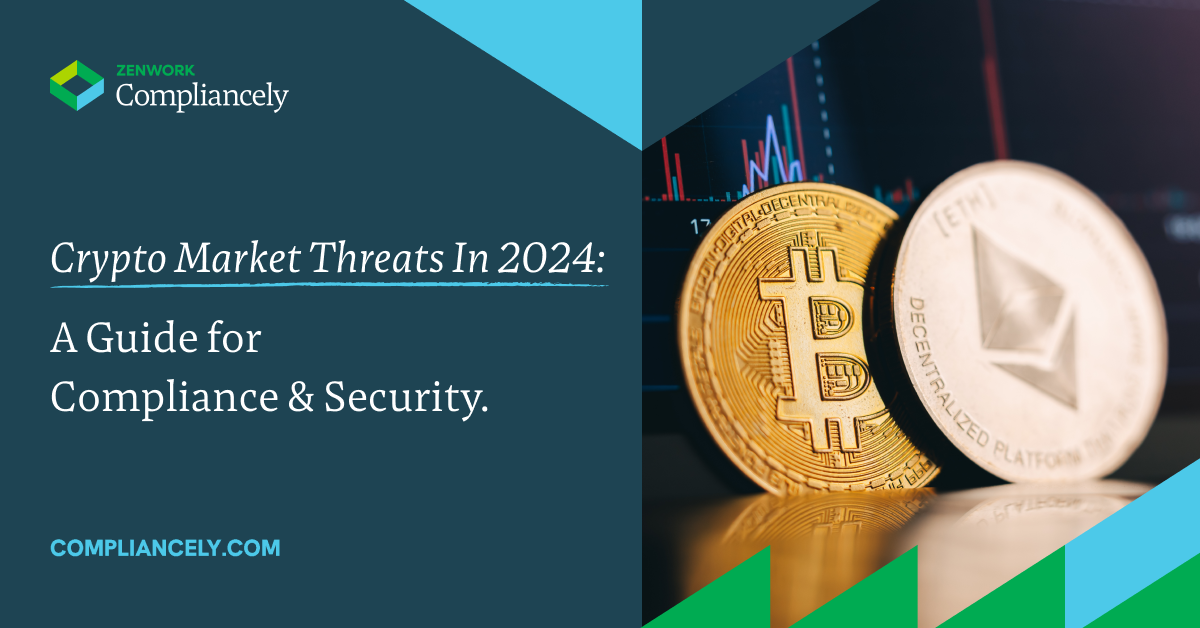Crypto Market Threats In 2024: A Guide for Compliance and Security

The cryptocurrency market is resurging from the debacle of 2022. That’s why the aftermath shows a sign of recovery in 2023, as it witnessed an increase in the market size to $1.72 trillion, a rise of $890 billion from $829 billion in 2022. This positive trend has also led to a decrease in the number of cryptocurrency fraud threats. The proof is in the declining numbers of illicit cryptocurrency addresses in 2023, from $39.6 billion to $24.2 billion.
The cryptocurrency market is at a critical juncture. To grow as it did in 2021, it needs to regain the trust of its stakeholders. To maintain this sentiment in the ecosystem, industry players must be on their toes and figure out what new trends are coming their way. Among the pressing challenges is the rise of social engineering and romance scams, alongside the persistent threat of money laundering facilitated by OFAC sanctions.
Let’s examine these challenges and explore what kind of solutions can mitigate these risks while ensuring regulatory compliance.
3 New Emerging Threats in the Cryptocurrency Market.
1. Introduction of New Regulations in Cryptocurrency Markets.
After the tumultuous events of 2022, the regulators have pulled up their socks to regularize the whole cryptocurrency ecosystem. Now, the government entities say that the industry needs a sense of responsibility and oversight. To give you all an understanding of how serious the authorities are, we can observe the firm stance that the Securities and Exchange Commission (SEC) has taken against a couple of industry giants. In the last year alone, the SEC ordered Binance to pay $4 billion in fines. Around five crypto companies faced SEC lawsuits in 2023.
In light of recent regulatory developments in the cryptocurrency industry, those involved in the crypto space must take proactive steps to adapt to the evolving landscape. It will enable them to reduce risks and take advantage of opportunities. These are some of the new regulations that may be implemented this year and you, being part of the industry, should know of:
1. Qualified Custodianship: The SEC aims to finalize a rule by April 2024 mandating investment advisors to safeguard customers’ crypto assets with “qualified custodians,” excluding traditional crypto exchanges.
2. Regulated Exchanges: Efforts are underway to broaden the definition of regulated exchanges to encompass crypto entities, including decentralized finance (DeFi) projects, ensuring greater oversight and accountability.
3. Stablecoin Regulation: The U.S. Congress is deliberating on legislation to regulate domestic stablecoin issuers, part of a comprehensive financial package with broader implications.
4. Enhanced Oversight: Regulatory bodies like the SEC and Commodity Futures Trading Commission (CFTC) have escalated enforcement actions against crypto firms, with over 200 proceedings initiated in 2023 alone, signaling a shift towards heightened regulatory scrutiny.
2. Rise of Crypto-Related Social Engineering and Romance Scams.
In 2023, the crypto industry saw a downturn in traditional scamming and hacking, with illicit revenues falling by over 29.2% and 54.3%. However, a new breed of threats emerged: social engineering and romance scams. What happens with these insidious tactics is that they prey on trust and exploit vulnerabilities in human psychology. Victims are manipulated through fake relationships or urgent financial requests, leading to devastating financial losses.
It has become a particularly challenging issue with romance scams, where fraudsters use the guise of romantic relationships to manipulate victims into making fraudulent investments. Alongside romance scams, there has been a rise in social engineering attacks using fake SMS messages and AI-generated content like deepfakes. These scams often masquerade as urgent financial requests from a known contact or present themselves as too-good-to-be-true giveaways.
Businesses in the crypto space are not immune to these sophisticated scams and are being targeted more by them. To combat this, robust identity verification solutions like Compliancely play a pivotal role. By verifying the identities of users and transactions, these solutions add a crucial layer of security, thwarting fraudsters’ attempts to exploit the system.
Read more about it: 5 Identity Verification Trends to Watch for in 2024.
3. OFAC Sanctions and Escalating Money Laundering via Crypto Bridges.
Cryptocurrency transactions are becoming increasingly susceptible to geopolitical influences. One of the most significant trends in crypto is the prevalence of sanctions-related transactions. In 2023, sanctioned entities accounted for a staggering $14.9 billion transaction volume, representing 61.5% of all illicit transactions measured during that year.
However, it’s imperative to recognize the rapid escalation of this threat. The rising tide of illicit activities facilitated by crypto bridges poses a grave challenge to businesses operating in the crypto space. Without decisive action, this trend threatens to engulf the industry, potentially subjecting businesses to heightened regulatory scrutiny and substantial penalties in the future.
To address this complex landscape, crypto platforms must adopt robust compliance measures by implementing additional layers of verification, strengthening identification protocols, and integrating comprehensive screening against OFAC and all sanctions lists. Identity verification solutions like Compliancely can play a crucial role in helping crypto platforms to implement these initiatives. By screening users against OFAC lists and other sanctions databases, platforms can identify potential exposure to sanctioned entities, ensure compliance with regulatory requirements, and minimize the risk associated with illicit transactions.
Read more about it - Red Flags For Potential OFAC Violations.
Way Forward.
The cryptocurrency market has shown signs of recovery from the challenges of 2022, as evidenced by positive trends in 2023. The market size has slightly increased while fraud threats have decreased. Looking ahead to the cryptocurrency market’s landscape in 2024, we must be aware of the looming threats posed by OFAC sanctions, money laundering, social engineering, and romance scams. These threats jeopardize financial stability and attract stricter regulations and increased scrutiny from regulatory bodies.
To navigate these challenges successfully, crypto platforms must prioritize the integration of extra layers of security into their processes. This includes robust identity verification measures, enhanced monitoring of transactions for suspicious activity, and continuous adaptation to evolving regulatory requirements. Failure to do so might attract hefty revenue losses in the form of penalties, revenue leakages, fraud.
Read more about it: What Are the Penalties For OFAC Violations?
While AI integration and tokenization offer new opportunities for growth and innovation, businesses must remain vigilant against these emerging threats. By investing in compliance and keeping pace with regulatory trends, companies can do more than just mitigate risks; they can establish themselves as trusted leaders within the crypto ecosystem. They can foster growth and sustain customer trust well into 2024 and beyond.
